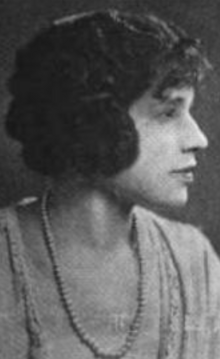Jane Dabney Shackelford
Jane Dabney Shackelford (October 16, 1895 – December 22, 1979) was an American educator and writer, based in Indiana.
Early life and education
[edit]Mary Jane Dabney was born in Clarksville, Tennessee, and raised in Logansport, Indiana, the daughter of George Brooks Dabney and Margaret (Maggie) Viola Stewart Dabney.[1] She graduated from Indiana State Normal College in 1919, and earned a master's degree from Columbia University in 1927.[2][3] She was a member of Alpha Kappa Alpha,[4] and Kappa Delta Pi.[5]
Career
[edit]Shackelford taught school in Terre Haute, Indiana for 43 years, fronm 1919 until she retired in 1962.[1] She also led a Girl Scout troop in Terre Haute, from 1936 into the 1950s.[6] To address a gap in the literature for elementary students, she wrote The Child's Story of the Negro (1938, with illustrations by Lois Mailou Jones),[7] and My Happy Days (1944, with photographs by fellow educator Cecil Vinton).[8][9]
Carter G. Woodson appreciated Shackelford's work,[7] and considered her to be a helpful early supporter of Black history content for young children. In addition to her books and teaching, she created booklets for young readers, as head of the Terre Haute branch of the Indiana Negro Historical Society.[10]
Publications
[edit]- The Child's Story of the Negro (1938, illustrated by Lois Mailou Jones)[11]
- My Happy Days (1944, with Cecil Vinton)[12]
Personal life and legacy
[edit]Dabney married Kyzer Shackelford in 1915. They had a son, Montrose, who served in World War II.[13] Shackelford died in 1979, at the age of 84. There is a collection of her scrapbooks and other papers in the Vigo County Public Library Archives.[14] Recent scholarship recognizes Shackelford's work as important early Black history for school use,[15] while noting that it holds contradictory messages about social integration and cultural distinctiveness, and presents Africa as exotic and primitive, both common narratives for its era.[16]
References
[edit]- ^ a b "Jane Dabney Shackelford". Indiana authors and their books 1917-1966. Retrieved 2024-02-04.
- ^ Horton, Charlotte (1945-01-27). "'My Happy Days' is Story of a Boy and His Home". The Buffalo News. p. 15. Retrieved 2024-02-04 – via Newspapers.com.
- ^ "Education 1928". The Crisis. 35 (8): 261. August 1928 – via Internet Archive.
- ^ "Jane Dabney Shackelford" Wabash Valley Profiles, via Indiana Memory.
- ^ "Negro Poets, Poems is Lecture Subject; Jane Dabney Shackelford Will Talk Here April 19". Battle Creek Enquirer. 1946-04-07. p. 14. Retrieved 2024-02-04 – via Newspapers.com.
- ^ "One of Terre Haute's Oldest Girl Scout Troops". The Terre Haute Tribune. 1952-10-27. p. 2. Retrieved 2024-02-04.
- ^ a b Woodson, Carter G. (1938-01-29). "Hoosier Schoolmarm Teaches Her Pupils To Be Proud of Race". The Pittsburgh Courier. p. 14. Retrieved 2024-02-04 – via Newspapers.com.
- ^ Shaw, Esther Popel (April 1945). "Jane Dabney Shackelford, My Happy Days". The Journal of Negro History. 30 (2): 219–221. doi:10.2307/2714837. ISSN 0022-2992. JSTOR 2714837.
- ^ "A Tribute to Jane Dabney Shackelford". Negro History Bulletin. 9 (7): 166. April 1946.
- ^ Dagbovie, Pero Gaglo (2007). The Early Black History Movement, Carter G. Woodson, and Lorenzo Johnston Greene. University of Illinois Press. pp. 99, 101–102. ISBN 978-0-252-07435-6.
- ^ Shackelford, Jane Dabney (1938). The Child's Story of the Negro. Associated Publishers.
- ^ Shackelford, Jane Dabney (1944). My Happy Days. Associated Publishers, Incorporated.
- ^ "Obituary for Montrose Shackelford". Journal and Courier. 1981-04-22. p. 16. Retrieved 2024-02-04 – via Newspapers.com.
- ^ "Collection: Jane Dabney Shackelford Collection". Vigo County Public Library. Retrieved 2024-02-04.
- ^ Nocera, Amato (February 2023). ""May We Not Write Our Own Fairy Tales and Make Black Beautiful?" African American Teachers, Children's Literature, and the Construction of Race in the Curriculum, 1920–1945". History of Education Quarterly. 63 (1): 32–58. doi:10.1017/heq.2022.41. ISSN 0018-2680.
- ^ Smith, Katharine Capshaw (2006-08-16). Children's Literature of the Harlem Renaissance. Indiana University Press. pp. 172–178. ISBN 978-0-253-21888-9.

